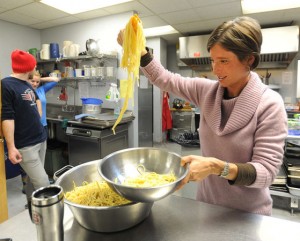Sena is a professor known for her passion and enthusiasm among the Villanova community, and she was  determined to start a similar project in Philadelphia. She began contacting churches, lawyers, and all those in charge of the Harvard shelter for advice and support. Then, she turned to her students. Sena expected a few to show up for the first meeting last spring. What she didn’t expect what the room to be jam-packed, standing room only. Less than a year after hearing the initial NPR Report, the Student-Run Emergency Housing Unit of Philadelphia (SREHUP) was up and running. The shelter has just completed its first winter season, and is already planning for the next.
determined to start a similar project in Philadelphia. She began contacting churches, lawyers, and all those in charge of the Harvard shelter for advice and support. Then, she turned to her students. Sena expected a few to show up for the first meeting last spring. What she didn’t expect what the room to be jam-packed, standing room only. Less than a year after hearing the initial NPR Report, the Student-Run Emergency Housing Unit of Philadelphia (SREHUP) was up and running. The shelter has just completed its first winter season, and is already planning for the next.
Similar to the Harvard Square Homeless Shelter, SREHUP is focused on instilling a sense of dignity and respect in their guests. However, unlike Harvard’s Shelter which runs on a two-week lottery basis (beds are offered for two weeks at a time through a lottery system), the same 30 guests are guaranteed the security of a safe place to stay for the entire winter. This provides them with the needed stability to look for permanent housing and a stable job.
If nothing else, Sena wants to emphasize one central point- “It’s not a band-aid, and it’s not a destination”. And to some degree, I agree. SREHUP works as emergency housing shelter at night, while concentrating on employment and housing opportunities for its guests during the day. The ultimate goal is for all residents to achieve permanent housing and stable employment in the immediate future. Therefore, their stay is supplemented with a variety of holistic programs including job training, SAT prep, tutoring, and computer literacy. Programs ranging from art and yoga lessons to money management classes are also run at the facility. In addition, students learn to advocate for legislation in issues concerning homelessness such as education reform, job creation, and fair housing initiatives. Some have already taken to Washinton D.C. And  as the shelter is almost 100% student run, the main emphasis is on student education concerning the issues of homelessness and homelessness prevention.
as the shelter is almost 100% student run, the main emphasis is on student education concerning the issues of homelessness and homelessness prevention.
With any social change, information gathering is a necessary first step. Education is next. With a board of 20 directors, and over 300 Philadelphia area college students from schools such as Villanova, Temple, Swarthmore, Penn, and Drexel involved in SREHUP, the message is spreading. Students are involved in all aspects of running the shelter- from fundraising, to media relations, to volunteer recruitment. The success of the first season is a testament to the student’s personal commitment to the cause.
It’s safe to say that SREHUP is not a band-aid for those living in the shelter. Not if the shelter truly provides their guests with the opportunity to receive permanent housing and employment in the future. However, it is yet another band-aid, an ever so small band-aid on the vast problem of homelessness, which is bursting at its seams.
Will SREHUP make a difference in the lives of 30 men, every single winter season? Undoubtedly. However, the stinging reality is that 30 more men will be lined up in the next winter season. What do you think would be a way to increase the impact of SREHUP and similar programs? What additional collaborative or collective efforts might assist in truly solving the issue of homelessness?


